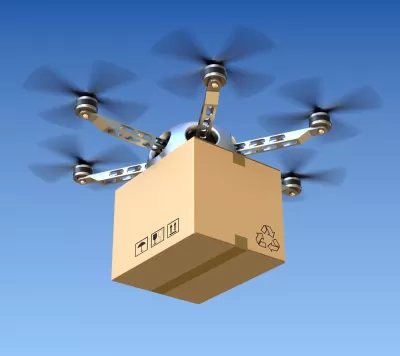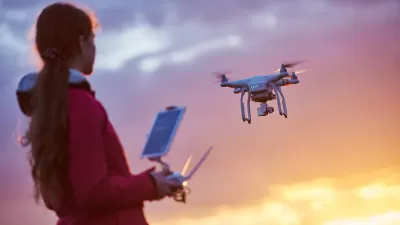In February, the Federal Aviation Administration released rules for the commercial operation of drones that were (to many observers) surprisingly business friendly. A landscape architect imagines the potential of drones for planning and design.

Jordan M. Peterson follows the news of the Federal Aviation Administration's recently released guidelines for commercial "Unmanned Aerial Vehicles" (otherwise known as drones), with a discussion of the potential of drones to influence the way planners and designers work.
"These small but complex machines will increasingly become a vital part of the landscape architect and planner’s toolkit; they will re-shape the 'imageability' of our cities, enabling a higher level of legibility in visual communication," writes Peterson in stating the thesis of his argument.
According to Peterson, we're likely to see drones become almost ubiquitous tools of the trade. "While the technology was nearly unattainable a few years ago, anyone can now purchase a ready-to-fly, GPS-stabilized, camera-equipped drone for the price of a cheap TV, effectively leveling the playing field in aerial imagery."
For a "blue-sky" wish for the potential of drones to influence the way we design and plan our cities, Peterson adds this: "Perhaps the most powerful use of the technology will be as a tool for both city and community governments and design and planning firms to aid in the public participation process. Used in conjunction with more traditional forms of media for community engagement, UAV imagery can help bridge the gap between two-dimensional, temporally-devoid satellite imagery and the more prosaic ground-based conventional camera."
FULL STORY: Drones Will Elevate Urban Design

Study: Maui’s Plan to Convert Vacation Rentals to Long-Term Housing Could Cause Nearly $1 Billion Economic Loss
The plan would reduce visitor accommodation by 25,% resulting in 1,900 jobs lost.

North Texas Transit Leaders Tout Benefits of TOD for Growing Region
At a summit focused on transit-oriented development, policymakers discussed how North Texas’ expanded light rail system can serve as a tool for economic growth.

Using Old Oil and Gas Wells for Green Energy Storage
Penn State researchers have found that repurposing abandoned oil and gas wells for geothermal-assisted compressed-air energy storage can boost efficiency, reduce environmental risks, and support clean energy and job transitions.

Private Donations Propel Early Restoration of Palisades Playground
Los Angeles has secured over $1.3 million in private funding to restore the Pacific Palisades playground months ahead of schedule, creating a modern, accessible space that supports community healing after recent wildfires.

From Blight to Benefit: Early Results From California’s Equitable Cleanup Program
The Equitable Community Revitalization Grant (ECRG) program is reshaping brownfield redevelopment by prioritizing projects in low-income and environmental justice communities, emphasizing equity, transparency, and community benefits.

Planting Relief: Tackling Las Vegas Heat One Tree at a Time
Nevada Plants, a Las Vegas-based nonprofit, is combating the city’s extreme urban heat by giving away trees to residents in underserved neighborhoods, promoting shade, sustainability, and community health.
Urban Design for Planners 1: Software Tools
This six-course series explores essential urban design concepts using open source software and equips planners with the tools they need to participate fully in the urban design process.
Planning for Universal Design
Learn the tools for implementing Universal Design in planning regulations.
Ascent Environmental
Borough of Carlisle
Institute for Housing and Urban Development Studies (IHS)
City of Grandview
Harvard GSD Executive Education
Toledo-Lucas County Plan Commissions
Salt Lake City
NYU Wagner Graduate School of Public Service



























